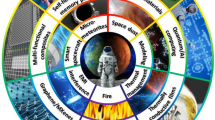Abstract
Long-duration human exploration beyond the low Earth orbit (LEO) mandates development of materials to minimize crew and equipment exposure to the interplanetary radiation environment. The potential for biological damage by the relatively low percentage of high-energy heavy ions in the galactic cosmic ray spectrum far outweigh that due to lighter particles because of their ionizing power and the quality of the resulting biological damage. To avoid paying a penalty due to additional weight, it would be beneficial to develop a multifunctional material as an integral part of a spacecraft structure to provide shielding effectiveness and structural integrity. This paper discusses the development of polyethylene fiber reinforced epoxy matrix structural composites that effectively satisfy both primary requirements.
Similar content being viewed by others
References
“Guidance on Radiation Received in Space Activities,” National Council on Radiation Protection and Measurements Report No. 98 (1989).
G.D. Badhwar and P. O’Neill, Adv. Space Res., 17(2) (1996), pp. 7–17.
J.W. Wilson, Health Phys., 79(5) (2000), p. 470.
M.A. Shea and D.F. Smart, Solar Phys., 127 (June 1990), pp. 297–320.
T.A. Parnell, J.W. Watts, and T.W. Armstrong, “Radiation Effects and Protection for Moon and Mars Mission,” Proceedings of the Sixth International Conference and Exposition on Engineering, Construction, and Operations in Space, Space 98 (Reston, VA: American Society of Civil Engineers, 1998), pp. 232–234.
H. Smith, editor, 1990 Recommendations of the International Commission on Radiological Protection, Annals of the ICRP, vol. 21/1–3 (New York: Pergamon Press, 1991).
“The Relative Biological Effectiveness of Radiations of Different Quality,” National Council on Radiation Protection and Measurements Report No. 104 (1990).
J.W. Wilson et al., NASA Technical Paper 3682 (Hampton, VA: Langley Research Center, December 1997).
J.E. Turner, Atoms, Radiation, and Radiation Protection, 2nd edition (New York: Wiley-Interscience Publishers, 1995), pp. 160–161, 350–351.
F.A. Cucinotta et al., Adv. Space Res., 17(2) (1996), pp. 77–86.
S. Guetersloh et al., Nucl. Instr. and Meth. in Phys. Res. B., 252 (2006), pp. 319–332.
R.K. Kaul, A.F. Barghouty, and H.M. Dache, “Radiation Transport Properties of Polyethylene-Fiber Composites,” Proceedings of the Conference on Microgravity Transport Processes in Fluid, Thermal, Biological, and Materials Sciences (New York: Annals of the New York Academy of Sciences, 2004), pp. 138–149.
J. Miller et al., Rad Res., 159 (2003), pp. 381–390.
J.W. Wilson et al., NASA Report #1257 (Washington, D.C.: NASA, 1994).
P.M. O’Neil, Adv. Space Res., 37 (2006), pp. 1727–1733.
F.C. Campbell, Manufacturing Technology for Aerospace Structural Materials, 1st edition (Amsterdam, The Netherlands: Elsevier Ltd., 2006).
D.M. Choi et al., Polymer, 38(25) (1997), pp. 6243–6249.
Reusable Launch Vehicle Technology Development and Test Program, report submitted by the Committee on Reusable Launch Vehicle Technology and Test Program (Washington, D.C.: National Academy Press, 1995).
ASM Materials Handbook, Volume 20 (Materials Park, OH: ASM International, 2001).
Aluminum Standards and Data (Arlington, VA: The Aluminum Association Publication, 2006), pp. 2-2–2-3.
G. Johnson and T. Holmquist, J. Appl. Phys., 85(12) (1999), pp. 8060–8073.
A. Tasdemirci and W. Hall, J. Comp Mat., 39(11) (2005), pp. 981–1005.
J.E. Pavlosky and L.G. St. Leger, NASA Technical Note # TN D-7564 (Washington, D.C.: NASA, January 1974).
Author information
Authors and Affiliations
Corresponding author
Rights and permissions
About this article
Cite this article
Sen, S., Schofield, E., O’Dell, J.S. et al. The development of a multifunctional composite material for use in human space exploration beyond low-earth orbit. JOM 61, 23–31 (2009). https://doi.org/10.1007/s11837-009-0019-5
Published:
Issue Date:
DOI: https://doi.org/10.1007/s11837-009-0019-5




